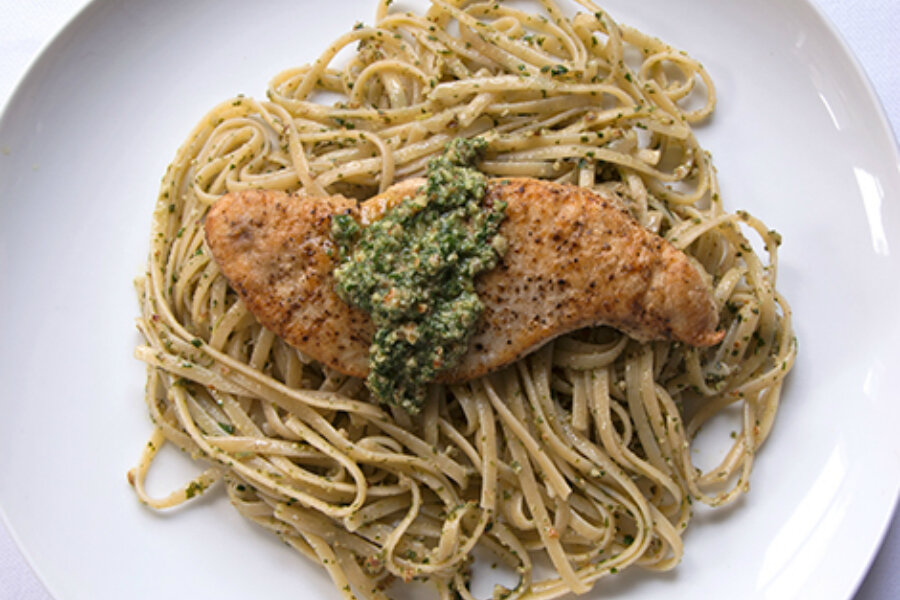Sage pecan pesto
Loading...
Our friend Gloria plants a veritable truck garden every year, mostly on her patio. In contrast to her, this spring we planted approximately nothing in our yard. As a result, that’s pretty much what we have growing there. Except for the sage. We planted it two or three years ago, and it’s surprised us every year since by coming back.
By the time the latest crop caught our eye several days ago, it was already blooming, with bountiful bunches of leaves waiting to be harvested. We love sage. We cook with it a lot here, both fresh and dried. The highly aromatic herb works well with pork, lamb, sausages, and other meats, bringing an assertive earthy flavor with a bit of lemon. Looking around for something new to do with it, we happened on the idea of sage pesto.
We also love pesto. It’s a flavorful, simple, no-cook salsa best known for summer pastas. If you search pesto in the Blue Kitchen archives, you’ll see that besides the classic basil version, we’ve made it with arugula, cilantro and even kale. We knew we would have to reel in the sage on this version – it can easily dominate a dish. So, as with many sage pesto recipes, parsley plays an uncredited but vital role, much like Bill Murray in "Tootsie."
Ultimately, we went ensemble, cast with everything in this pesto. Instead of the usual walnuts in most sage pesto recipes, we used sweeter, lighter pecans. We dialed back on the garlic, too, using one clove instead of the more common two or three. To make up for the more subtle garlic presence, we added lemon juice and zest. The result was lively and big-flavored, as pesto should be, but with no one dominant flavor.
We used our Sage Pecan Pesto two ways for our dinner the other night. We tossed some of it with linguine and spooned some of it over thin-sliced chicken breast fillets seasoned with salt and pepper, dredged in flour and sautéed in olive oil and butter. It was a meal we were still talking about days later. The pesto would also be delicious spooned over steaks, chops or fish, either grilled or sautéed. I could see stirring some of it into a soup or tossing roasted vegetables with it as well.
Sage Pecan Pesto
Makes about 1 cup (enough for 1 pound of pasta, about 4 servings)
1/2 cup pecan halves
1 cup fresh sage leaves, packed
1 cup flat parsley leaves, packed
1 large garlic clove, minced
1/3 cup freshly grated good quality Parmesan
1/2 teaspoon salt
zest of 1/2 lemon and 2 tablespoons lemon juice
1/2 cup good quality olive oil
hot water (if making pasta, use reserved pasta water)
linguine or other ribbon pasta
1. Toast the pecan halves in a dry medium skillet over medium-low heat, stirring frequently, just until they are fragrant, about 3 to 5 minutes. Transfer to a plate and cool completely. If you’re making pasta, start a pot of water for it now.
2. Combine pecans, sage, parsley, garlic, Parmesan, salt, and lemon zest and juice in the bowl of a food processor. Pulse several times to coarsely chop and combine everything. Add olive oil and blend to proper consistency. Don’t overprocess – you want a little texture to the pesto. You may need to scrape down the sides with a spatula and pulse mixture to get an even consistency. Add a little bit of hot water as needed to thin it.
3. Drain pasta and return to pot. Toss with pesto and serve.
Related post on Blue Kitchen: Kale lemon pesto with fettucine






